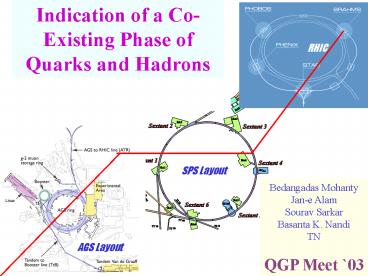AGS Layout PowerPoint PPT Presentation
1 / 14
Title: AGS Layout
1
Indication of a Co-Existing Phase of Quarks and
Hadrons
RHIC
SPS Layout
Bedangadas Mohanty Jan-e Alam Sourav
Sarkar Basanta K. Nandi TN QGP Meet 03
AGS Layout
2
(No Transcript)
3
High Energy Cosmic ray nucleus-nucleus collisions
T.H. Burnett et al., PRL 57, 3249 (1986)
4
Fermilab expt (p-p) data from E735
T.Alexopoulus et al., PRL 64, 991 (1990)
5
Background We are confronted daily with the
phase transition from liquid to gas -- for
example every time we boil water. Now we use the
simulation to help our understanding of the
microscopic properties of water that change when
a phase transition occurs. At the boiling point
of any liquid, a large fraction of molecules
possess kinetic energy high enough to break
bonds with the bulk liquid. That is, the pressure
within the liquid is greater than the
outside'' pressure and the liquid
evaporates,'' resulting in a departure of
molecules from the bulk fluid. The PV--phase
diagram of water (Fig. 4.2.1) shows that as we
lower the pressure, the volume increases.
However this curve does not continue linearly
its decline comes to a halt and for a period the
volume can increase without a change in
pressure. The curve has a plateau in this region.
Then the curve continues its downward slope.
This interruption marks the phase transition from
liquid to gas. When the liquid evaporates, its
pressure does not rise, because the system
expands at the same time (provided the the NPT
ensemble has been chosen.)
6
Transverse Mass Spectra
NA49 Kaon spectrum from 12.A GeV
7
AGS
SPS
RHIC
8
(No Transcript)
9
QGP or not - thats the question
- The following issues are addressed
- Hydrodynamical Calculation with and without QGP
- Estimation of Initial Temperature
- From hadrons
- From photons and dileptons
- Comparison with lattice QCD predictions
- (3) Does Cronin effect come to play?
- (4) Checks using a standard event generator
10
Hydrodynamical Calculation
For a system undergoing (31) dimensional
expansion we solve the hydrodynamical equations
for various initial energy densities (ei). mT
spectra are obtained for hadrons as a function of
(ei) for two different kinds of space-time
evolution scenario (a) hadron gas
Input Freeze-out temperature 120 MeV
(b) QGP Inputs Freeze-out
temperature 120 MeV
Critical temperature 170 MeV gt
mixed phase exists between ei of 0.56 to 1.7
GeV/fm3 and QGP phase
beyond 1.7 GeV/fm3
11
Results from hydrodynamical calculation
Hadronic scenario QGP scenario
- Although a complete plateau
- structure is not observed we
- find that
- mT varies at a much slower
- rate for QGP compared to
- the hadronic scenario.
- Formation of a mixed phase
- slows down the rate of
- increase of mT with
- multiplicity.
12
Estimation of Initial Temperature (I)
Teff (inverse slope of mT spectra) contains the
effect of flow and can be parameterized as
By using we get
For ltvrgt0.4, we get ltmTgt 315 MeV for SPS
energies Which implies Ti gt 158 MeV
13
Estimation of Initial Temperature (II)
From photon spectra of WA98 expt. at CERN-SPS
inverse slopw parameter is 275 MeV.
For ltvrgt0.4, Tav 178 MeV. Thus the
initial temperature is larger than 178 MeV at SPS
energies which is similar to that predicted by
lattice QCD calculations.
Estimation of Thermalization time (ti )
For SPS energies, we get ti lt 1.2 fm/c
14
Cronin effect
Effect similar to that of Cronin effect where
hadrons gain transverse momentum through
successive collisions with the particles in the
system is considered. This is studied as a
random walk of the hadrons in the medium. The
spectra of pions could be reproduced by this, but
not of kaons and protons.
Using HIJING
HIJING doesnt reproduce the observed behavior.

